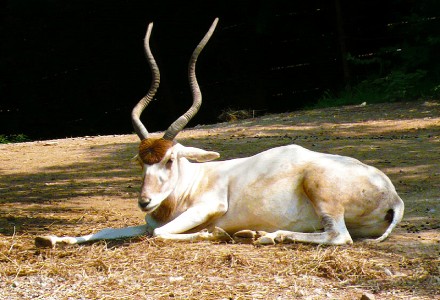
Screwhorn Antelope Facts
- The most noteworthy fact about the Screwhorn Antelope remains its distinctively curved horns. Quite understandably, these serve as the source of the remarkable common name. Yet this highly impressive animal actually has far more than that.
- The IUCN presently classifies this animal as Critically Endangered. That status appears on its Red List of Threatened Species. The beautiful animal holds this status due to growing concerns mount over its uncertain future.
- The majority of its remaining numbers remain concentrated in one small area, but rare stragglers do occur. Furthermore, this species also ranks as one of the first animals known to have been domesticated by early man.
- In fact, archaeological evidence indicates this happened an extraordinary amount of time in the past. The domestication of the visually impressive species apparently first began more than 4,500 years ago.
- The extreme hardiness of the Screwhorn Antelope stands as one of the reasons this species was domesticated so early in history. It evolved that characteristic because of the climate it inhabits. Most of this consisted of arid desert regions.
Related Articles
Photographer: Haytem93
CC License: https://bit.ly/3AvtsDT
Screwhorn Antelope Physical Description
Arguably, the Screwhorn Antelope has a unique set of horns. These display two or three sharp twists and average up to 31 in (80 cm) in length. As a matter of fact, in exceptional individuals, these may reach lengths of as much as 43 in (110 cm).
The coats also vary in color with the seasons: gray-brown in winter and almost white in summer. In addition, this fabulous animal species also displays the physiological trait of sexual dimorphism. In its case, that presents itself in terms of size.
Females average slightly less in both mass and height than the males. Meanwhile, although females remain slimmer, both genders average a head and body length of about 51 in (130 cm). But the differences between genders does not end there.
Males of the Screwhorn Antelope attain an average shoulder height measuring about 45 in (115 cm). But the females of the species remain slightly shorter. Males also attain weights of as much as 275 lb (125 kg). Yet the females rarely exceed 200 lb (90 kg).
- Kingdom: Animalia
- Phylum: Chordata
- Class: Mammalia
- Order: Artiodactyla
- Family: Bovidae
- Genus: Addax
- Species: A. nasomaculatus
Public Domain Image
Screwhorn Antelope Distribution, Habitat, and Ecology
The Screwhorn Antelope ha a very limited distribution in the wild today. However, it once roamed a much larger portion of this part of the world. In point of fact, that original range consisted of much of the Saharan region of Africa.
Unfortunately, the range of the creature now remains limited to a fraction of that area. Sadly, the only known self-sustaining population of this species in the wild today lives in what now forms the Termit Massif Reserve, in Niger.
Its natural habitat also played a truly pivotal role in its evolution. This habitat type primarily consists of both sandy and stony deserts. Nevertheless, the magnificent bovine also appears within other arid regions.
These other areas of habitation most commonly consist of such locations as regions of thorn scrub. In addition to this, scattered individuals occasionally roam into other regions. Unfortunately, though, these rarely remain for any length of time.
The fascinating Screwhorn Antelope also typically forms small herds numbering 5-20 individuals. These usually follows the oldest female. This species primarily consume grasses and the leaves of any shrubs it can find, including bushes and herbs.
This animal also developed yet another remarkable attribute, That’s the fact that it has the ability to survive for extended periods of time without water. Finally, its principal natural predators, given its range, include cheetahs and leopards.
Species Sharing Its Range
Medusas Head Somersaulting Spider Bat-Eared Fox
Check out our other articles on Magnificent Mammals of Australia, Darwin’s Orchid, Blood Falls, Himalayan Blue Poppy, Mary River Turtle, Spanish Moss, Saint Francis’ Satyr Butterfly

